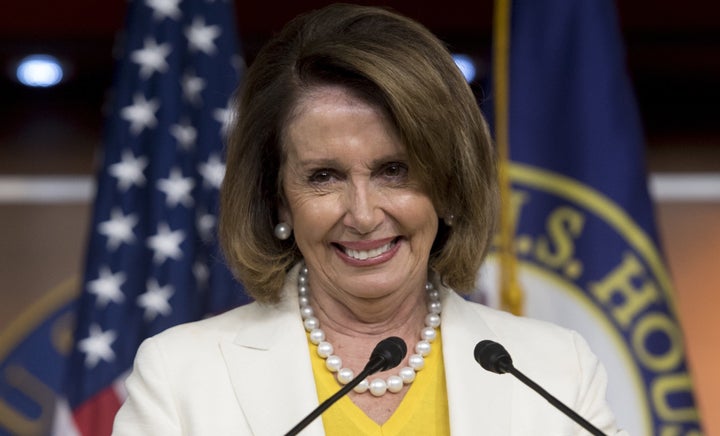
How discouraged should Democrats be after failing to win any of the four recent House special elections to fill vacancies? The losses, most recently of Jon Ossoff, in Georgia’s 6th district, triggered a blame game, directed against House leader Nancy Pelosi, the Democratic National Committee, the tacticians of the Democratic Congressional Campaign Committee, and candidate Ossoff himself.
For starters, consider the numbers. Every one of these races was a long shot, and in every case the Democrat did notably better than his counterpart in 2014 or 2016.
Ossoff lost by 3.7 points. In 2016, the Democrat lost the seat by 16.2 points. In other words, Ossoff improved the Democratic performance by more than 12 points.
Likewise in the Kansas 4th district election of April 11, Democrat James Thompson lost by 6.8 points. But in the 2016 election, the Democrat lost by a massive 24.6 percent. The swing was 17.8 points to the Democrat.
In South Carolina’s 5th district election June 20, a sleeper race which did not compete seriously for national funding, Democrat Archie Parnell lost by just 3.2 points—less than 3,000 votes―and benefited from a swing of over 10 points compared to 2016. Even in the May contest for Montana’s at large seat, Democrat Rob Quist gained 2.7 points relative to the 2016 House race, and did almost 11 points better than Trump.
The average Democratic gain in these four long-shot races was about ten points. If that average were to hold nationwide in 2018, Democrats would comfortably take back the House.
But what about the charge that House leader Nancy Pelosi, at 77 and representing liberal San Francisco, presents the wrong image for the national party? Republican Karen Handel, who won the Georgia seat, made Pelosi her target. Her first ad declared:
Nancy Pelosi’s hand-picked candidate, Jon Ossoff, who doesn’t even live in the district, is not one of us and cannot be trusted to stand up for Georgia’s 6th District. It is clear by the overwhelming support from D.C. liberals, Ossoff would be nothing more than another Pelosi lackey in Congress falling in line with House Democrats and out of touch with Georgia values.
In the wake of Ossoff’s defeat, Ohio’s Congressman Tim Ryan, who challenged Pelosi for the leadership last November (and was trounced in the House Democratic Caucus, 134-63), resumed his drumbeat of criticism of the leadership, saying that the Democratic brand was “toxic” in much of the country where Democrats were seen as “not being able to connect with the issues they care about.”
“Our brand is worse than Trump,” he said flatly.
It’s certainly true that Hillary Clinton in 2016 failed to connect to working class voters on the issue of economic distress. But it’s a bit much to pin that on Pelosi.
Throughout the Obama years, Pelosi was much more of an economic progressive than either Obama or Clinton, opposing trade deals like the Trans Pacific Partnership, and pushing hard for increased stimulus spending. She has also been superb at holding the House Democratic caucus together.
Ryan, for his part, is trying to carve out a role as more conservative on social issues but populist on economic issues like reviving manufacturing. He opposed abortion, but then flipped in 2015 and announced his support for reproductive choice. He also has interesting views for a social conservative, being a big supporter of the local food revolution and an active practitioner of meditation.
Ryan may well have a future as a national Democratic leader, but Nancy Pelosi is the wrong scapegoat. And if you listen to the adjectives tossed around, there is whiff of sexism in the air. Search the words: Pelosi, shrill, woman of a certain age, and hectoring, and you’ll get the drift.
Republicans have been running against Nancy Pelosi and the “San Francisco Democrats” since at least 1988. That didn’t stop Barack Obama from being elected—twice—on a message of hope. And if Hillary Clinton paid too little attention to the working class in between picking up checks from Goldman Sachs, that was hardly Nancy Pelosi’s fault.
Ossoff himself did not run a great campaign, but in an affluent suburban district of Atlanta, it’s not clear that he would have done better as an economic populist. (He might have done better had he lived in the district.)
What is clear is that the campaign professionals at the Democratic National Committee and the Democratic Congressional Campaign Committee were asleep at the switch, with the obsessive focus on the Ossoff race. The races in Kansas and South Carolina, it turned out, were more winnable, but got almost no attention or resources.
Bottom line: Even though there were no gains of seats, there was an impressive swing to the Democrats in these four races that portends major pickups in 2018. Georgia’s 6th district was number 71 on the list of likely Democratic gains based on its recent voting history. The Democrats need only 24 to take back the House. That said, the Democrats do need to pick up their game and become a lot more strategic about their campaigns.
Robert Kuttner is co-editor of The American Prospect and professor at Brandeis University’s Heller School. His latest book is Debtors’ Prison: The Politics of Austerity Versus Possibility.
Like Robert Kuttner on Facebook: http://facebook.com/RobertKuttner
Follow Robert Kuttner on Twitter: www.twitter.com/rkuttner
